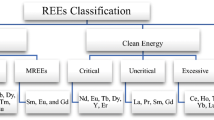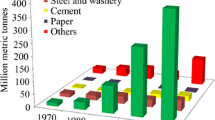Abstract
Optical microscopy, x-ray diffraction and selective x-ray fluorescence spectrometry, SEM/EDS and laser ablation-micro-ICP-AES have been used to study the minerals and the concentrations of 15 trace elements in coal from the Upper Silesian Coal Basin. Mineral matter has a significant impact on the contents of V, Cr, Co, Cu, As, Rb, Sr, Cd, Ba and Pb in coal and organic matter on the contents of Ni, Zn, Mo, Sn and Sb in coal. Contents of V, Cr, Cu, Rb, Sr and Ba are most probably dependent on clay minerals and those of V and Rb on both clay minerals and vitrinite. Organic matter and carbonate minerals likely determine contents of Mn, and mineral matter and vitrinite likely determine contents of Co and Pb are probably influenced by sulphides. The bulk of the V, Cr, Mn, Co, Ni, Cu, Rb, Sr, Mo, Sb and Ba in the coal is probably of syngenetic origin. In contrast, the contents of Zn, As, Cd and Pb and, to a degree, those of Mn, Ni, Mo and Sb are epigenetic. Analysis results in the micro-area of minerals from bituminous coal reveal that the greater the heterogeneity of disulphides and of their association with carbonates and the more this heterogeneity applies to epigenetic minerals, the higher the contents of Ca, Cr, Mn, Ni, Zn, Cd and Pb. Diagenetic carbonates have higher contents of Cr, Mn and Ni, and smaller contents of Ca, Zn, Cd and Pb than the epigenetic minerals. These characteristics can be important from an ecological perspective; they identify which mineral matter components are best removed from coal to make it more suitable for combustion and in chemical processing.






Similar content being viewed by others
References
Alastuey A, Jiménez A, Plana F, Querol X, Suárez-Ruiz I (2001) Geochemistry, mineralogy, and technological properties of the main Strphanian (carboniferous) coal seams from the Puertollano Basin, Spain. Int J Coal Geol 45:247–265
Bai X, Wang Y, Li W (2014) Mineralogy, distribution, occurrence and removability of trace elements during the coal preparation of no. 6 coal from Heidaigou mine. Int J Coal Sci Techn 1:402–420
Baioumy HM (2009) Mineralogical and geochemical characterization of the Jurasic coal from Egypt. J African Earth Sci 54:75–84
Dai S, Ren D, Tang Y, Shao L, Li S (2002) Distribution, isotopic variation and origin of Sulphur in coals in the Wuda coalfield, Inner Mongolia, China. Int J Coal Geol 51:237–250
Dai S, Hou X, Ren D, Tang Y (2003) Surface analysis of pyrite in the no. 9 coal seam, Wuda coalfield, Inner Mongolia, China, using high-resolution time-of-flight secondary ion mass-spactrometry. Int J Coal Geol 55:139–150
Dai S, Ren D, Chou C-L, Finkelman RB, Seredin VV, Zhou Y (2012) Geochemistry of trace elements in Chinese coals: a review of abundances, genetic types, impacts on human health, and industrial utilization. Int J Coal Geol 94:3–21
Deditius AP, Utsunomiya S, Reich M, Kesler SE, Ewing RC, Hough R, Walshe J (2011) Trace metal nanoparticles in pyrite. Ore Geol Rev 42:32–46
Diehl SF, Goldhaber MB, Koenig AE, Lowers HA, Ruppert LF (2012) Distribution of arsenic, selenium, and other trace elements in high pyrite Appalachian coals: evidence for multiple episodes of pyrite formation. Int J Coal Geol 94:238–249
Dill HG, Bechtel A, Kus J, Gratzer R, Abu Hamad AMB (2010) Deposition and alteration of carbonaceous series within a Neotethyan rift at the western boundary of the Arabian plate: the late Permian um Irna formation, NW Jordan, a petroleum system. Int J Coal Geol 81:1–24
Duffus JH (2002) “Heavy metals”—a meaningless term? (IUPAC technical report). Pure Applied Chem 74:793–807
Edress NAA, Opluštil S, Sýkorová I (2018) Depositional environments of the Jurassic Maghara main coal seam in north Central Sinai, Egypt. J African Earth Sci 140:241–255
Finkelman RB, Palmer CA, Wang P (2018) Quantification of the modes of occurrence of 42 elements in coal. Int J Coal Geol 185:138–160
Gluskoter HJ, Ruch RR, Miller WG, Cahill RA, Dreher GB, Kuhn JK (1977) Trace elements in coal: occurrence and distribution. Illinois State Geol Survey 499:1–154
Goodarzi F, Sanei H, Stasiuk D, Bagheri-Sadeghi H, Reyes J (2006) A preliminary study of mineralogy and geochemistry of four coal samples from northern Iran. Int J Coal Geol 65:35–50
Górecka E, Kozłowski A, Kibitlewski S (1996) The Silesian-Cracow Zn-Pb deposits, Poland, considerations on ore-forming processes. In: Górecka E, Leach DL, Kozłowski A (eds) Carbonate-hosted zinc-lead deposits in the Silesian-Cracow area, vol 154. Papers of the Polish Geological Institute, Poland, pp 167–182
Gürdal G (2011) Abundances and modes of occurrence of trace elements in the Çan coals (Miocene), Çanakkale-Turkey. Int J Coal Geol 87:157–173
Hower JC, Robi TL, Anderson C, Thomas TA, Sakulpitakphon T, Mardon SM, Clark WL (2005) Characteristics of coal combustion products (CCP’s) from Kentucky power plants, with emphasis on mercury content. Fuel 84:1338–1350
Huggins FE, Shah N, Huffman G, Kolker A, Crowley S, Palmer CA, Finkelman RB (2000) Mode of occurrence of chromium in four US coals. Fuel Proc Techn 63:79–92
Huggins FE (2002) Overview of analytical methods for inorganic constituents in coal. Int J Coal Geol 50:9–214
International Classification of Seam Coals, Final Version, 1995. Economic Commission for Europe, Committee On Energy, Working Party On Coal, Fifth Session, Genève
ISO/TS 12902, 2001. Solid mineral fuels. TC 27/SC 5: Methods of Analysis. International Organization for Standardization, Geneva
Jiang Y, Qian H, Zhou G (2016) Mineralogy and geochemistry of different morphological pyrite in late Permian coals. South Chin Arab J Geosci 9:590
Jureczka J, Kotas A (1995) Coal deposits. In: Zdanowski A, Żakowa H (eds) Upper Silesian Coal Basin: the carboniferous system in Poland, 148. The works of Polish Geol. Institute, Warsaw, pp 164–173
Jureczka J, Dopita M, Gałka M, Krieger W, Kwarciński J, Martinec P (2005) Geological atlas of coal deposits of the polish and Czech parts of the upper Silesian Coal Basin. Publ. Polish Geol. Institute, Warsaw
Kalaitzidis S, Siavalas G, Skarpelis N, Araujo CV, Christanis K (2010) Late cretaceous coal overlying karstic bauxite deposits in the Parnassus-Ghiona unit, Central Greece: coal characteristics and depositional environment. Int J Coal Geol 81:211–226
Karayigit AI, Spears DA, Booth CA (2000) Antimony and arsenic anomalies in the coal seams from the Gokler coalfield Gediz. Turkey Int J Coal Geol 44:1–17
Kettanah Y, Eble CF (2017) Petrology, mineralogy and geochemistry of Hemrin coal seam, Hemrin South Mountain, northern Iraq. J Coal Geol 181:39–59
Ketris MP, Yudivich YE (2009) Estimations of Clarkes for carbonaceous biolithes: world avarages for trace element contents in black shales and coals. Int J Coal Geol 78:135–148
Kolker A (2012) Minor element distribution in iron disulfides in coal: a geochemical review. Int J Coal Geol 94:32–43
Kolker A, Finkelman RB (1998) Potentially hazardous elements in coal: modes of occurrence and summary of concentration data for coal components. Int J Coal Prep Utiliz 19:133–157
Lewińska-Preis L, Fabiańska MJ, Ćmiel S, Kita A (2009) Geochemical distribution of trace elements in Kaffiovra and Longyearbyen coals Spitrsbergen Norway. Int J Coal Geol 80:211–223
Malon A, Tymiński M (2009) Hard coals. In: Szuficki M, Malon A, Tymiński M (eds) Balance of mine resources from groundwater in Poland according to 31 XII, vol 2008. Publisher: Polish Geol Institute-National Research Institute, Warsaw, pp 1–18
Marczak M (1985) Genesis and regularities of the trace elements occurrence in the Chełm coal deposit at Coal Basin of Lublin. Sci Work Silesian Univer 748:1–109
Moenke-Blankenburg L, Gäckle M, Günther D, Kammel J (1990) Plasma source mass spectrometry. In: Jarvis HE et al (eds) The proceedings of the third Surrey conference on plasma source mass spectrometry, University of Surrey, July 16th-19th, 1989, vol 1-17. Royal Society of Chemistry, Cambridge, p 1990
Moosavirad SM, Rasouli J, Janardhana MR, Moghadam MR, Shankara M (2013) Petrographic, mineralogy, and geochemistry of coals of Pabedana, Kerman Province, Central Iran. Arab J Geosci 6:3623–3634
Oliveira MLS, Ward CR, Sampaio CH, Querol X, Cutruneo CMNL (2013) Partitioning of mineralogical and inorganic geochememical components of coals from Santa Catarina, Brazil, by industrial beneficiation processes. Int J Coal Geol 116 - 117:75–92
Padgett PL, Rimmer SM, Ferm JC, Hower JC, Eble CF, Mastalerz M (1999) Sulfur variability and petrology of the lower block coal member (Pensylvanian) in Southwest Indiana. Int J Coal Geol 39:97–120
Parzentny H (1994) Lead distribution in coal and coaly shales in the upper Silesian Coal Basin. Geol Quaterly 38:43–58
Parzentny H, Lewińska-Preis L (2006) The role of sulphide and carbonate minerals in the concentration of chalcophile elements in the bituminous coal seams of a paralic series (upper carboniferous) in the upper Silesian Coal Basin (USCB), Poland. Chem Erde-Geochemistry 66:227–247
Piedad-Sánchez N, Suárez-Ruizb I, Martíneza L, Izarta A, Eliea M, Keravis D (2004) Organic petrology and geochemistry of the carboniferous coal seams from the central Asturian Coal Basin (NW Spain). Int J Coal Geol 57:211–242
Ratafia - Brown JA (1994) Overview of trace elements partitioning in flames and furnaces of utility coal-fired boilers. Fuel Proc Techn 39:139–157
Różkowski A, Rudzińska T. Bukowy S 1979 Thermal brines a potential Skurce of the ore mineralization of the Silesia – Cracow area. In: Malinowski J ed Research of the genesis of zinc – lead deposits of upper Silesia, Poland. Geol Publ Warsaw, pp 59–85
Song DY, Zhang XK, Zhang JY, Zheng CG (2010) Migration characteristics of hazardous trace elements in coal in the process of flotation. J China Coal Soc 35:1170–1176
Suárez-Ruiz D, Flores D, Marques MM, Martinez-Tarazana MR, Pis J, Rubiera F (2006) Geochemistry, mineralogy, and technological properties of coals from Rio Maior (Portugal) and Penarroya (Spain) basins. Int J Coal Geol 67:171–190
Tang Y, Chang C, Zhang Y (2009) Migration and distribution of fifteen toxic trace elements during the coal washing of the Kailuan coalfield, Hebei Province, China. Energy Exploration Exploitation 27:143–152
Toprak S (2009) Petrographic properties of major coal seams in Turkey and their formation. Int J Coal Geol 78:263–275
Vasconcelos LS (1999) The petrographic composition of world coals. Statistical results obtained from a literature survey with reference to coal type (maceral composition). Int J Coal Geol 40:27–58
Wiese RG, Muir IJ, Fyfe WS (1990) Trace-element siting in iron sulphides in Ohio coals determined by secondary ion mass spectrometry (SIMS). Int J Coal Geol 14:155–174
Yudovich YaE, Ketris MP (2005) Toxic trace elements in coals. Russian Acadamy of Sciences, Ural Division Komi Scientific Centre, Institut of Geology, Ekaterinburg, pp. 1–655
Životić D, Wehner H, Cvetković O, Jovančićević B, Gržetić I, Scheeder G, Vidal A, Šajnović A, Ercegovac M, Simić V (2008) Petrological, organic geochemical and geochemical characteristics of coal from the Soko mine, Serbia. Int J Coal Geol 73:285–306
Acknowledgements
The authors wish to thank Professor Liesolette Moenke-Blankenburg and Dr. Jens Kammel from the Martin Luther University in Halle for access to their Laser Ablation-Micro-ICP-AES laboratory. Dr. Padhraig Kennan (University College Dublin) and Dr. Magdalena Misz-Kennan (Silesian University, Katowice) are thanked for help with language.
Author information
Authors and Affiliations
Corresponding author
Electronic supplementary material
ESM 1
(XLSX 181 kb)
Rights and permissions
About this article
Cite this article
Parzentny, H.R., Róg, L. Modes of occurrence of ecotoxic elements in coal from the Upper Silesian Coal Basin, Poland. Arab J Geosci 11, 790 (2018). https://doi.org/10.1007/s12517-018-4134-x
Received:
Accepted:
Published:
DOI: https://doi.org/10.1007/s12517-018-4134-x




